【冀教版】九年级英语Unit1教案
- 格式:doc
- 大小:256.50 KB
- 文档页数:6
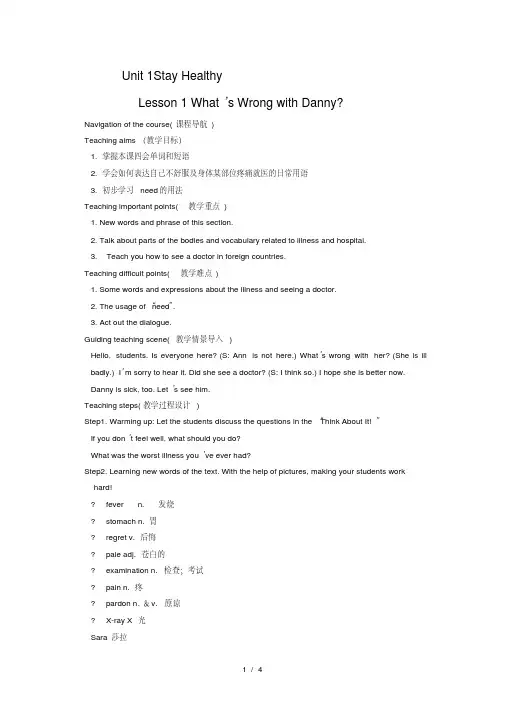
Unit 1Stay HealthyLesson 1 What’s Wrong with Danny?Navigation of the course(课程导航)Teaching aims(教学目标)1. 掌握本课四会单词和短语2. 学会如何表达自己不舒服及身体某部位疼痛就医的日常用语3. 初步学习need的用法Teaching important points(教学重点)1. New words and phrase of this section.2. Talk about parts of the bodies and vocabulary related to illness and hospital.3. Teach you how to see a doctor in foreign countries.Teaching difficult points(教学难点)1. Some words and expressions about the illness and seeing a doctor.2. The usage of “need”.3. Act out the dialogue.Guiding teaching scene(教学情景导入)Hello, students. Is everyone here? (S: Ann is not here.) What’s wrong with her? (She is ill badly.) I’m sorry to hear it. Did she see a doctor? (S: I think so.) I hope she is better now. Danny is sick, too. Let’s see him.Teaching steps(教学过程设计)Step1. Warming up: Let the students discuss the questions in the “Think About It!”If you don’t feel well, what should you do?What was the worst illness you’ve ever had?Step2. Learning new words of the text. With the help of pictures, making your students work hard!?fever n. 发烧?stomach n. 胃?regret v. 后悔?pale adj. 苍白的?examination n. 检查;考试?pain n. 疼?pardon n.&v. 原谅?X-ray X光Sara 莎拉Step3. Listening tasks: Listen to the tape twice and then tell the sentences are true or false.Danny’s head hurt.Danny and his father went to the hospital by taxi.Danny had to stay in hospital that night.Step4. Reading tasks. Read the text with the following questions, and then answer them, please.?What did Danny eat??He ate ten donuts.?What’s wrong with Danny??His stomach hurt and he got a fever.?What did the doctor do to Danny??He feels Danny’s stomach.Step5. Explain the text and then learn the language notes.1. It’s 3:00 a.m., Danny wakes up his parents. 凌晨3点,丹尼叫醒了他的父母。
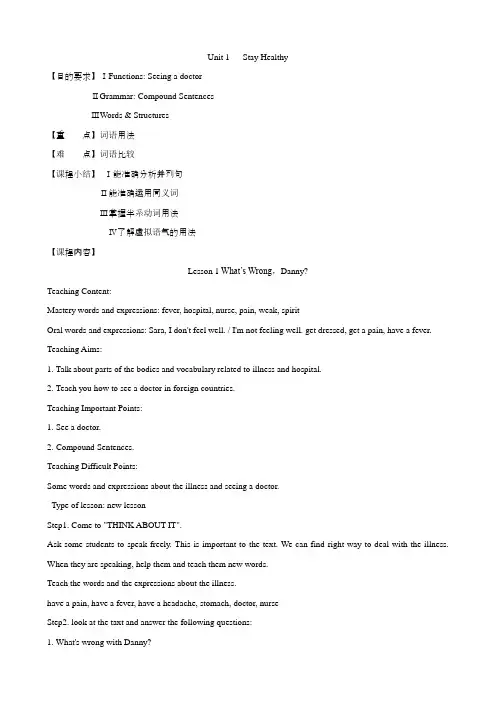
Unit 1 Stay Healthy【目的要求】ⅠFunctions: Seeing a doctorⅡGrammar: Compound SentencesⅢWords & Structures【重点】词语用法【难点】词语比较【课程小结】Ⅰ能准确分析并列句Ⅱ能准确运用同义词Ⅲ掌握半系动词用法Ⅳ了解虚拟语气的用法【课程内容】Lesson 1 What’s Wrong,Danny?Teaching Content:Mastery words and expressions: fever, hospital, nurse, pain, weak, spiritOral words and expressions: Sara, I don't feel well. / I'm not feeling well. get dressed, get a pain, have a fever. Teaching Aims:1. Talk about parts of the bodies and vocabulary related to illness and hospital.2. Teach you how to see a doctor in foreign countries.Teaching Important Points:1. See a doctor.2. Compound Sentences.Teaching Difficult Points:Some words and expressions about the illness and seeing a doctor.Type of lesson: new lessonStep1. Come to "THINK ABOUT IT".Ask some students to speak freely. This is important to the text. We can find right way to deal with the illness. When they are speaking, help them and teach them new words.Teach the words and the expressions about the illness.have a pain, have a fever, have a headache, stomach, doctor, nurseStep2. look at the taxt and answer the following questions:1. What's wrong with Danny?2. Does Danny have to stay in hospital?This is a difficult task for the students. If the questions are a little difficult, they can't answer them. But we don't have time to let them listen again.Step3. Read the text.Read the text and check the answers in listening part. Encourage the students to ask more questions about this part. Such as:When does Danny feel unwell?What does Mr. Dinosaur think of Danny's illness?Does Danny have a fever?Is the hospital always open?Who is the doctor?What does the doctor say to Danny?Check the answers and give them enough hints to answer the questions.词汇详解I don’t feel wellwell (1) adj. 身体健康的(只有形容身体情况的时候作形容词)(2) adv. 好的;令人满意的eg. Are you feeling well?The party went well.2. sick : 生病的sick 与ill 的区别(1)sick 可做表语和定语,意思是“生病的”; 还可用来表示“反胃的”eg. When she became sick/ill, I called in a doctor f or her.You’re a sick man, I must look after you.car/shi psick 晕车/船的(2)ill 表示“生病的”(可与sick替换); 做定语意思是“坏的,恶劣的”eg. He has an ill temper. 他脾气坏.ill “有病的” 通常作表语作定语时是“bad”的意思sick “有病的” 既可作表语又可作定语His father is ill/sick in bed.She feels ill/sick. He looks ill/sick.her sick mother 她生病的妈妈her ill/bad mother 她的坏妈妈3. pain : (1)(身体上的)疼痛;(精神上的)痛苦eg. His behavior caused his parents a great deal of pain.(2)辛苦eg. take pains 尽力,努力4. wake… up : 把…叫醒eg. I tried to wake up my wife by ringing the door bell.eg. Please wake me up at 8 o’clock.注: 当宾语是名词时,可放在动词wake和副词up之间或放在up之后; 当宾语是代词时,只可放在动词wake 和副词up之间5.What’s wrong, Danny?发生什么了?What’s wrong with sb./sth?= What’s the matter with sb./sth.?= What’s the trouble with sb./sth.?6. regret doing sth后悔做某事eg. I’m regret eating too many donuts .7 You have got a bad(high) feverhave got 不是get的现在完成时态形式,而是表示“有,拥有”,相当于have,该结构不用于过去时态中She has got a lot of money. = She has a lot of money.Have you got a computer? = Do you have a computerget a fever / have a fever 发烧have a fever = have a temperature8. get dressed : 穿衣(表动作)注:用作不及物动词,后不加宾语eg. Get dressed quickly, or you will be late.get dressed “穿上衣服”get undressed “脱下衣服”be dressed in “穿着……衣服” 强调状态She was dressed in a green dress.get 连系动词,用于表示事物状态的变化。
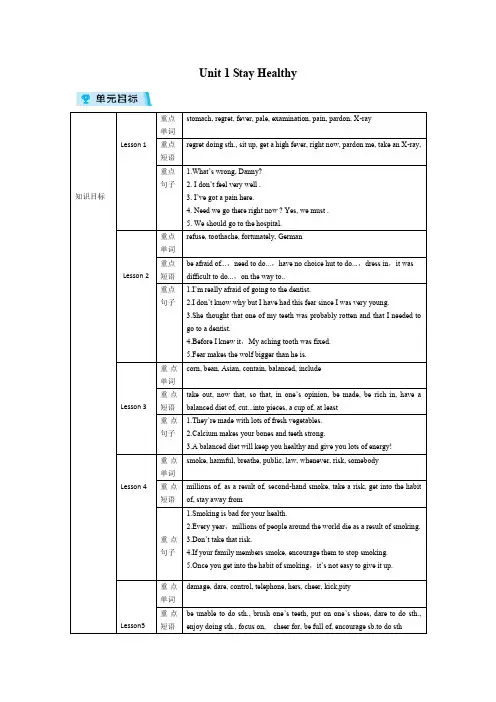
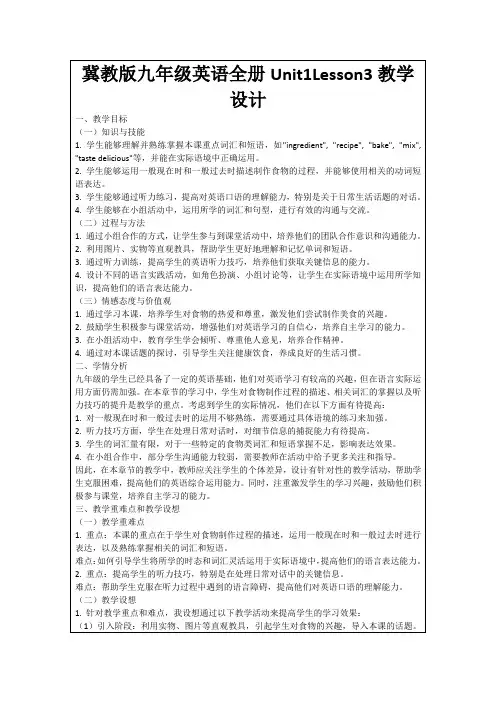
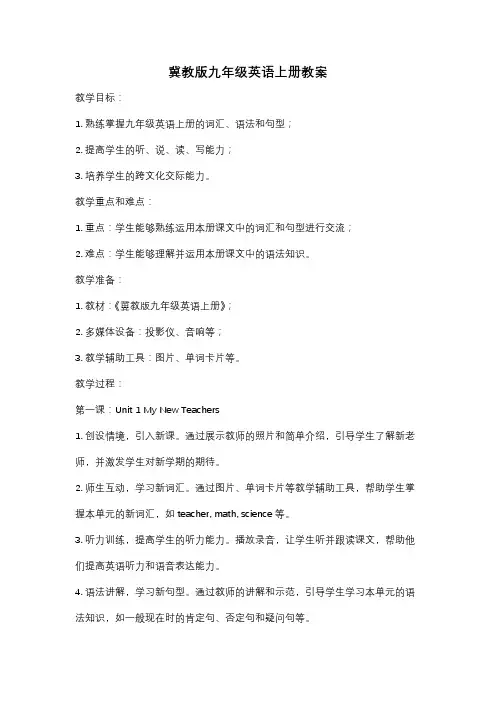
冀教版九年级英语上册教案教学目标:1. 熟练掌握九年级英语上册的词汇、语法和句型;2. 提高学生的听、说、读、写能力;3. 培养学生的跨文化交际能力。
教学重点和难点:1. 重点:学生能够熟练运用本册课文中的词汇和句型进行交流;2. 难点:学生能够理解并运用本册课文中的语法知识。
教学准备:1. 教材:《冀教版九年级英语上册》;2. 多媒体设备:投影仪、音响等;3. 教学辅助工具:图片、单词卡片等。
教学过程:第一课:Unit 1 My New Teachers1. 创设情境,引入新课。
通过展示教师的照片和简单介绍,引导学生了解新老师,并激发学生对新学期的期待。
2. 师生互动,学习新词汇。
通过图片、单词卡片等教学辅助工具,帮助学生掌握本单元的新词汇,如teacher, math, science等。
3. 听力训练,提高学生的听力能力。
播放录音,让学生听并跟读课文,帮助他们提高英语听力和语音表达能力。
4. 语法讲解,学习新句型。
通过教师的讲解和示范,引导学生学习本单元的语法知识,如一般现在时的肯定句、否定句和疑问句等。
第二课:Unit 2 My School Day1. 复习巩固,巩固词汇和语法知识。
通过小组活动、游戏等形式,让学生进行词汇和语法知识的复习巩固,加深对知识点的理解和掌握。
2. 阅读训练,提高学生的阅读能力。
让学生阅读课文,理解文章内容,并进行相关问题的讨论和回答,提高学生的阅读理解能力。
3. 书面表达,培养学生的写作能力。
通过让学生描述自己的一天,或者写一篇关于学校生活的短文,培养学生的书面表达能力。
第三课:Unit 3 My Weekend1. 听力训练,提高学生的听力能力。
播放录音,让学生听并跟读课文,帮助他们提高英语听力和语音表达能力。
2. 口语训练,提高学生的口语表达能力。
通过角色扮演、小组讨论等活动,让学生进行口语训练,提高他们的口语表达能力。
3. 跨文化交际,培养学生的跨文化交际能力。
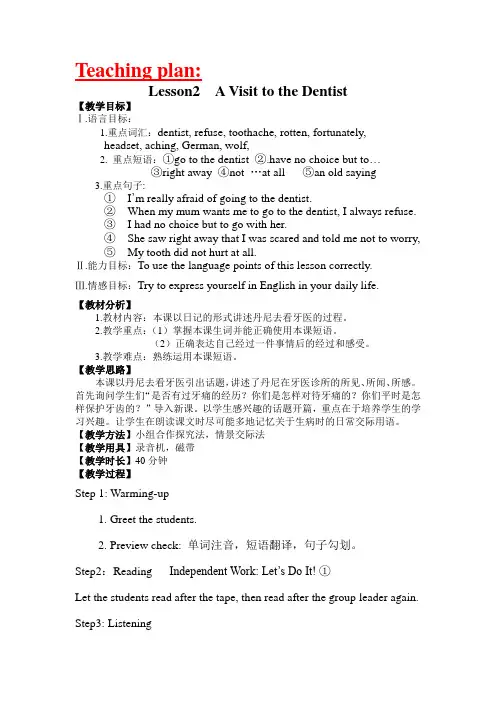
Teaching plan:Lesson2 A Visit to the Dentist【教学目标】Ⅰ.语言目标:1.重点词汇:dentist, refuse, toothache, rotten, fortunately,headset, aching, German, wolf,2. 重点短语:①go to the dentist ②.have no choice but to…③right away ④not …at all ⑤an old saying3.重点句子:①I’m really afraid of going to the dentist.②When my mum wants me to go to the dentist, I always refuse.③I had no choice but to go with her.④She saw right away that I was scared and told me not to worry,⑤My tooth did not hurt at all.Ⅱ.能力目标:To use the language points of this lesson correctly.Ⅲ.情感目标:Try to express yourself in English in your daily life.【教材分析】1.教材内容:本课以日记的形式讲述丹尼去看牙医的过程。
2.教学重点:(1)掌握本课生词并能正确使用本课短语。
(2)正确表达自己经过一件事情后的经过和感受。
3.教学难点:熟练运用本课短语。
【教学思路】本课以丹尼去看牙医引出话题,讲述了丹尼在牙医诊所的所见、所闻、所感。
首先询问学生们“是否有过牙痛的经历?你们是怎样对待牙痛的?你们平时是怎样保护牙齿的?”导入新课。
以学生感兴趣的话题开篇,重点在于培养学生的学习兴趣。
让学生在朗读课文时尽可能多地记忆关于生病时的日常交际用语。
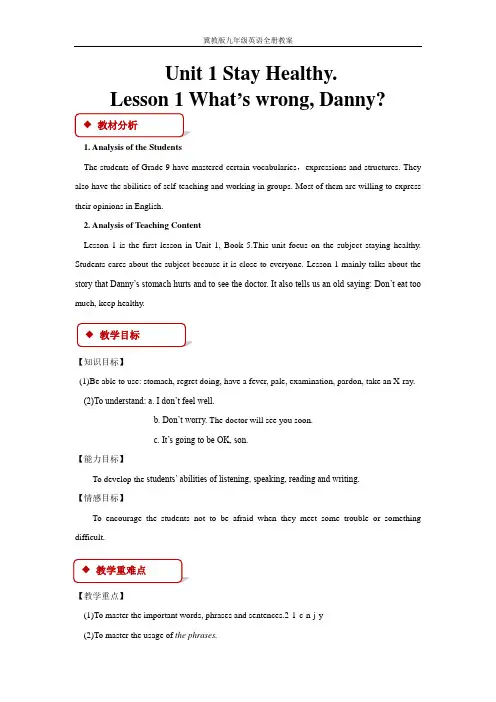
Unit 1 Stay Healthy.Lesson 1 What’s wrong, Danny?1. Analysis of the StudentsThe students of Grade 9 have mastered certain vocabularies,expressions and structures. They also have the abilities of self-teaching and working in groups. Most of them are willing to express their opinions in English.2. Analysis of Teaching ContentLesson 1 is the first lesson in Unit 1, Book 5.This unit focus on the subject staying healthy. Students cares about the subject because it is close to everyone. Lesson 1 mainly talks about the story that Danny’s stomach hurts and to see the doctor. It also tells us an old saying: Don’t eat too much, keep healthy.【知识目标】(1)Be able to use: stomach, regret doing, have a fever, pale, examination, pardon, take an X-ray.(2)To understand: a. I don’t feel well.b. Don’t worry. The doctor will see you soon.c. It’s going to be OK, son.【能力目标】To develop the students’ abilities of listening, speaking, reading and writing.【情感目标】To encourage the students not to be afraid when they meet some trouble or something difficult.【教学重点】(1)To master the important words, phrases and sentences.2·1·c·n·j·y(2)To master the usage of the phrases.【教学难点】To understand the whole lesson and make a new dialogue.Tape recorder, MultimediaStep 1. Warm-up1. Sing the song.2. Ask and questions:T: If you don’t feel well, what should you do?Students: see a doctor, take some medicine, drink some water, have a rest more.Step 2. Presentation1.Show the picture and guess: What’s wrong with Danny?2.Listen to the text and tell the sentences true or false.(1.) At three o'clock in the morning, Danny has got a pain in his stomach, so he wakes his parents up. ( )(2.) Mr. Dinosaur think Danny ate so much donuts so his stomach hurts. ()(3.) They go to the hospital by taxi. ( )(4.) Though it's very late in the night, the hospital is still open. ( )(5.) A doctor talked to Mr. Dinosaur and took them to a room.( )(6.) Mrs. Dinosaur will stay with Danny.()3.Listen the text again and tick the correct answers.(1)What’s wrong with the woman?She has a high fever.She has a cold.(2) Did the medicine help her get well?Yes, it did.No, it didn’t.(3) What advice did the man give to the woman?She should go to see the doctor.She should try other medicine.4.Read the text and answer the questions.(1) Why does Danny wake up his parents early in the morning?(2) What does Danny regret doing?(3) How do they get to the hospital?(4) What does Dr. Ling ask Danny to do?5. Show the language points:wake up 醒来,把吵醒,叫醒sit up 坐起来have got a fever 发烧arrive at 到达talk with 同……说话look up 查阅,在书中查到point to 指向turn to 转向6. Explain the language points:At 3:00 AM, Danny wakes up his parents. 凌晨3点,但你叫醒了他的父母。
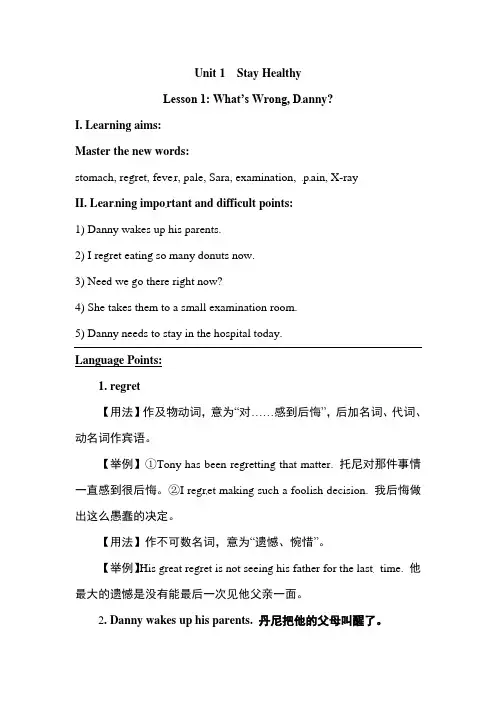
Unit 1 Stay HealthyLesson 1: What’s Wrong, D anny?I. Learning aims:Master the new words:stomach, regret, fever, pale, Sara, examination, p ain, X-rayII. Learning important and difficult points:1) Danny wakes up his parents.2) I regret eating so many donuts now.3) Need we go there right now?4) She takes them to a small examination room.5) Danny needs to stay in the hospital today.Language Points:1. regret【用法】作及物动词,意为“对……感到后悔”,后加名词、代词、动名词作宾语。
【举例】①Tony has been regretting that matter. 托尼对那件事情一直感到很后悔。
②I regret making such a foolish decision. 我后悔做出这么愚蠢的决定。
【用法】作不可数名词,意为“遗憾、惋惜”。
【举例】His great regret is not seeing his father for the last time. 他最大的遗憾是没有能最后一次见他父亲一面。
2. Danny wakes up his parents. 丹尼把他的父母叫醒了。
【用法】短语wake up意为“叫醒”,这是“动词+副词”短语。
这类短语用名词作宾语时,名词可在副词前,也可用在副词后;如用代词作宾语时,代词则必须用在副词前。
故这句话中的wake up his parents 还可说为wake his parents up。
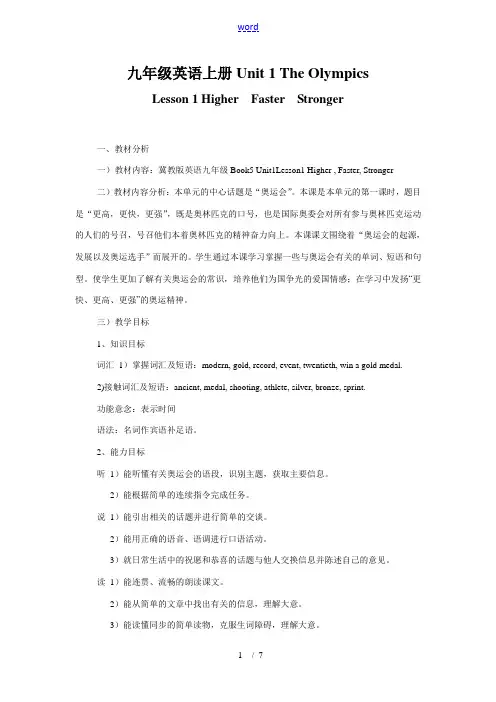
九年级英语上册Unit 1 The OlympicsLesson 1 Higher Faster Stronger一、教材分析一)教材内容:冀教版英语九年级Book5 Unit1Lesson1 Higher , Faster, Stronger二)教材内容分析:本单元的中心话题是“奥运会”。
本课是本单元的第一课时,题目是“更高,更快,更强”,既是奥林匹克的口号,也是国际奥委会对所有参与奥林匹克运动的人们的号召,号召他们本着奥林匹克的精神奋力向上。
本课课文围绕着“奥运会的起源,发展以及奥运选手”而展开的。
学生通过本课学习掌握一些与奥运会有关的单词、短语和句型。
使学生更加了解有关奥运会的常识,培养他们为国争光的爱国情感;在学习中发扬“更快、更高、更强”的奥运精神。
三)教学目标1、知识目标词汇1)掌握词汇及短语:modern, gold, record, event, twentieth, win a gold medal.2)接触词汇及短语:ancient, medal, shooting, athlete, silver, bronze, sprint.功能意念:表示时间语法:名词作宾语补足语。
2、能力目标听1)能听懂有关奥运会的语段,识别主题,获取主要信息。
2)能根据简单的连续指令完成任务。
说1)能引出相关的话题并进行简单的交谈。
2)能用正确的语音、语调进行口语活动。
3)就日常生活中的祝愿和恭喜的话题与他人交换信息并陈述自己的意见。
读1)能连贯、流畅的朗读课文。
2)能从简单的文章中找出有关的信息,理解大意。
3)能读懂同步的简单读物,克服生词障碍,理解大意。
4)能理解课文中事件发生的顺序和人物行为。
写1)能用词组和简单句写有关奥运会的短文。
2)能在老师的帮助下练习和修改有关奥运会的作文。
3、学习策略目标1)树立自主学习的概念和意识。
2)能总结所学语言材料中的语言规律并加以利用。
3)善于抓住用英语交际的机会。
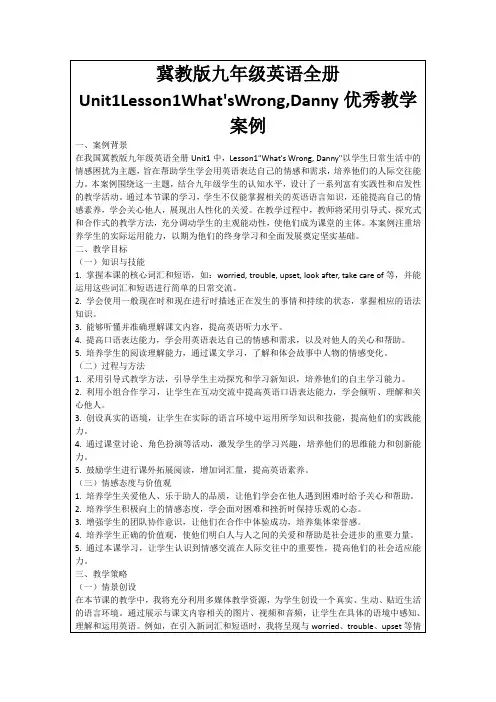
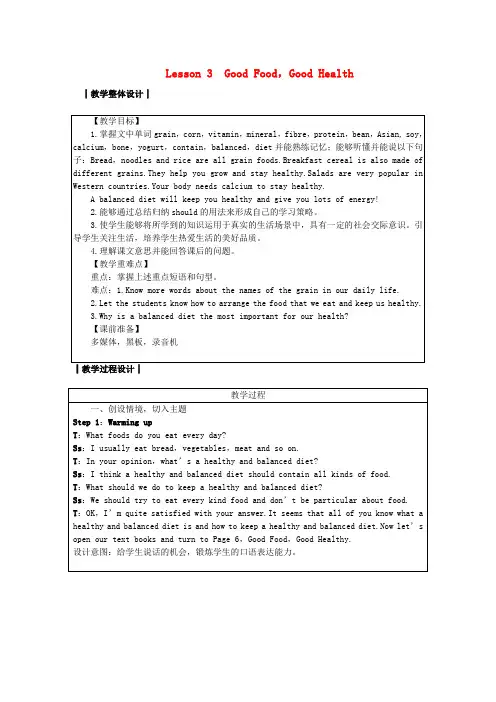
Unit 1 Stay Healthy Lesson 2 A visit to the Dentist知识目标单词dentist,refuse,toothache,rotten,fortunately ,headset,aching,German,wolf词组take care of, be afraid of, have no choice but to do sth.句型At the age of ten,I had a bad cold. I had a high fever. I’m really afraid of going to thedentist. I had no choice but to go with her.技能目标能听懂本课时的听力材料,能说出本课时的重要句型,能运用句式用英语谈论学习方法掌握文中重点短语be afraid of...,need to do...,have no choice hut to do...,dress in,it was difficult to do...,on the way to...和句型I’m really afraid of going to the dentist.I had no choice but to go with her.能准确应用本课中的词汇dentist,refuse,toothache,rotten,fortunately,headset,aching,German,wolf.一、创设情境,切入主题Step 1:Warming upT:Have you ever had a toothache?Ss:Yes,I have.T:What do you do when you have a toothache?Ss:I go to the dentist’s.T:How do you take care of your teeth?Ss:I brush my teeth twice a day and go to the dentist’s regularly.T:Wow!You really take good care of your teeth!I hope all of you can keep your teeth healthy!OK,now let’s learn a new text about toothache and dentist.二、展开过程,探究新知Step 2:Presentation1.帮助学生创设情境编演一个小对话,让他们两人一组模仿编演。
冀教版九年级上册Unit1教案Unit 1 The OlympicsLesson 1:Higher, Faster, StrongerTeaching Content:Mastery words and expressions: modern, gold, record, event, twentiethOral words and expressions: ancient, Athens, Beamon, medal, shooting, athlete, silver, bronze, sprintTeaching Aims:1. Learn about the history of Olympics.2. Encourage the students to work hard for our country.Teaching Important Points:1. Learn something about the Olympics.2. Wishes and congratulations.Teaching Difficult Points:Some words and expressions used in the Olympics. Teaching Preparation: some pictures of OlympicsTeaching Aids: audiotape, flashcards, picturesType of lesson: new lessonTeaching Procedure:Step1.Show some pictures of Olympics to the class. Let the students say something about the Olympics. Show some newwords to the students with the help of the pictures. At the end, introduce the topic of the unit to the class.e to “THINK ABOUT IT.”Step3.Listen to the tape and answer the following questions.1. When were the first Olympics?2. When did the modern Olympics start?Step4.Now let’s learn how to use the new words. Make some sentences with the new words. Sometimes they can guess the meanings of the new words.Step5. Read the text and find out the words that stand for places, time, medals, sports and events.Places: Greece, Athens, Sydney, Mexico City, Los Angeles Time: ancient, modern, BC (Before Christ), ADMedals: gold, silver, bronzeSports and events: race, sprint (a short race), long jumping, shootingStep6. Discuss the main ideas of the text. Answer the questions in Quick Quiz! Have the students talk about the history, sports and events, and famous athletes of the Olympics.Step7. Divide the class into several groups. Talk about the 2008 Olympics Games. What do the students know about it?e to “LET’S DO IT”.Play the game in the class. Divide the class into several groups. Then each group have a student in front of the class to imitate a sport. The others guess by using “Is it______?”Step9. Homework1. Finish the activity.2. Search on the Internet for more words about the Olympics.Summary:Today’s subject is familiar to the students, but the English words about the Olympics are difficult for them. So we must spend a little time to deal with the new words. Show some pictures to help the students know more about Olympics. The pictures also help the students know about the history of Olympics.Lesson 2: Swimming for GoldTeaching Content:Mastery words and expressions: close, race, seem, tie, up and down, beat, the others, volleyballOral words and expressions: Barcelona, freestyle, Thompson, swimmer, spectatorTeaching Aims:1. The sports that Chinese are good at.2. Stimulate students’ learning interest.Teaching Important Points:1. Express wishes and congratulations.2. Learn Direct Speech and Indirect Speech.Teaching Difficult Points:Direct Speech and Indirect SpeechTeaching Preparations: picturesTeaching Aids: audiotape, flashcards, picturesType of lesson: new lessonTeaching Preparation:Step1. Play a game.Divide the class into several groups. Every group says a sport. The others must say two sentences about the sport. When they are in trouble, the others and the teacher can help them e to “THINK ABOUT IT’.Talk about swimming.1. What do you think of swimming?2. Where do you like to swim?3. Is swimming good for us? Is it dangerous?Let the students talk about the questions in pairs. Then give their answers in front of the class.If you like swimming, you must pay attention to the safety. Don’t go swimming alone. Don’t swim in the deep water. You must keep touch with the others.Step3.Listen to the tape and answer the following questions:1. Who won China’s first gold in swimming?2. Who was the second in the match?If the students can’t write Jenny Thompson correctly, please write it on the blackboard for them.Step4. DiscussLet the students talk about the swimming about China. They can talk according to the following order.The players’ names: Zhuang Yong, Luo Xuejuan, Qian Hong, Lin Li, Yang WenyiThe events: freestyleStep5. Read the text and analyze the text in details.1. In which event did Zhuang Yong win the gold medal?2. Was it a tie?3. Did she win the other medals at the same time?4. Who else won Olympic medals in swimming at the 1992 Olympic Games?e to “LET’S DO IT.”Divide the class into several groups. Talk about why they canget the gold medal. What can we learn from them?It’s their love to our country that supports them to get the gold. They need spirit to overcome themselves. That’s what we need in our learning.Step7. Homework1. Finish off the activity book.2. Go on the nest reading in the student book.Summary:We are Chinese. We are proud of ourselves. How can Zhuang Yong get the gold medal? They love our country. They want to do better than the others. It’s not easy for them to get medals. They pay their sweat and hard work. What can we do now? We must study hard from now.Lesson 3: Are You an AthleteTeaching Content:Mastery words and expressions: volleyball, table tennis=ping-pong, luck, tennisOral words and expressions: design, rope, jump rope, sit-up, push-upTeaching Aims:1. Learn about the Olympics events.2. Cultivate the spirit to compete in life and study.Teaching Important Points:1. The Direct Speech and Indirect Speech.2. The Object Clause.3. Wishes and Congratulations.Teaching Difficult Points:The Direct Speech and the Indirect Speech.Teaching Preparation: some ballsTeaching Aids: audiotape, flashcards, picturesType of lesson: new lessonTeaching Procedure:Step1. Divide the class into groups. One student acts, the others in the group gue ss the sport. Let’s see which group can get the most scores.Step2. Show the students the language points with the flashcards. Such as: the same as, good luck, jump over, two more timesMake sentences with the expressions.The book is the same colour as that one.Good luck to you.Don’t jump over the wall. It’s too high.You can jump two more times.Step3. Class OlympicsHave a class Olympics in the classroom. The teacher brings rope and ball to the classroom. Divide the class into several groups. Every group has two students in front of the class at a time. One student is the player, the other is the timekeeper. Now compete in the classroom.Step4. Listen to the tape and answer the following questions: What’s Danny’s idea?Step5. Read the text and find out what Jenny’s idea is. Is it OK? At the same time, practice how to express wishes and congratulations.e to PROJECTLet the students find out the event that they fit. They must think carefully:What will they need if they want to have the event?How many people do they need?How will you keep the score?How will you measure the time?Step7. Homework1. Finish the activity book.2. Go on reading the student book.Summary:We have classroom Olympics in our classroom. It’s good forthe stu dents. It will increase students’ interest of learning English. Prepare some techniques before the class. Keep the time in one minute. You’d better give them praise if they get the first. When they are doing the sports, let the others practice the expressions: good luck, the same to you, congratulations.Lesson 4: Good Luck to YouTeaching Content:Mastery words and expressions: do one’s best, give up, believeTeaching Aims:1. Learn more about the Olympics.2. Study hard for our country.Teaching Important Points:1. Wishes and congratulations.2. Some language points.Teaching Difficult Points:Some language points: do one’s best, good luck to you, up and down, believe inTeaching Preparation: picturesTeaching Aids: audiotape, flashcards, picturesType of lesson: new lessonTeaching Procedure:Step1.Show some pictures of the champions. Liu Xiang got the gold medal in 110-metre hurdle race. Show the picture to the students. Then let them listen to the Chinese song.Step2.Show more pictures of Chinese athletes to the students. Then let them discuss the following questions:Who is the athlete? What does he do?How many Olympics did he take part in?Did he get medals in the Olympics?Step3. Listen to the tape and sing the song together. If they can’t follow it, play the tape again.Step4. Read the tape as a poem. Then show some language points to the class. Let them make sentences with the language points or organize a short passage. Remember the language points in a certain situation.Step5. Let the students sing after you. Act out when you are singing. All the students stand up and sing loudly.e to “LET’S DO IT”Divide the class into several groups. Every group sends a few students to the front to tape part in some events. Begin the events, while the others cheer for their players. Try their cheers or songs in the class. We can change it as the eventschange.Summary:Play songs of our country or show more pictures of our country’s athletes. Let the students fe el the strength of our country. All the people come to the same place to complete. We remember friendship is the first and the competition is the second.Lesson 5:Danny’s Very Special GuestTeaching Content:Mastery words and expressions: guest, such, able, great, practiseOral words and expressions: Jeff JohnsonTeaching Aims:1. Know more about the foreign athletes.2. Know the saying: Failure is the mother of success. Teaching Important Points:1. The tense of the object clause.2. The use of the Direct Speech and Indirect Speech. Teaching Difficult Points:The tense of the object clause.Teaching Preparation: picturesTeaching Aids: audiotape, flashcards, picturesType of lesson: new lessonTeaching Procedure:Step1. C ome to “THINK ABOUT IT”.Ask some students to answer the questions. If some students can imitate the famous singer or player, they can act in front of the class.Ask the students to come to the front and act. The others guess who the man is and what his job is.Step2. Listen to the tape and answer the following questions.1. Who will come to Danny’s school?2. What does the man do?Step3. Read the text. Encourage the students to ask questions by themselves.1. Why does Danny have to write the diary?2. What’s Danny’s favourite sport?3. What should Danny do if the wants to be in Olympics some day?Step4.DiscussionImagine you are a report. You are going to see your favourite star today. What will you ask him. Work with your partner. Now imagine he is the star.After five minutes, ask the students to act their dialogue out infront of the class.Step5. Come to “LET’S DO IT”.Give them a little time. Then let the students finish it in front of the class.After a student tells his story, the others can ask questions. Step6. Homework1. Finish off the activity book.2. Go on the next reading in the student book. Summary:We all have dreams so we like film stars or players. Sometimes we don’t think we can do well in class. But we are better at swimming or skating. Everyone has shortcomings. If we want to do better, we must work hard at it. If we need help, we can ask our classmates and teachers for it. Work on!Lesson 6: Diving “Dream Team”Teaching Content:Mastery words and expressions: dream, age, victory, catch up withOral words and expressions: Dream Team, Sydney, dive, diver, Atlanta, platform, springboard, champion, coachTeaching Aims:1. Learn about the spirit of Olympics.2. Works hard to have our dreams come true.Teaching Important Points:1. Know more about the Chinese Dream Team.2. The history of diving in the Olympics.Teaching Difficult Points:Understand the history of the Chinese diving.Teaching Preparation: picturesTeaching Aids: audiotape, flashcards, picturesType of lesson: new lessonTeaching Procedure:Step1. Come to “THINK ABOUT IT”.Ask the students what they think of the Dream Team. Talk about the Dream Team of China. What sports are much stronger in China?Let the students work in pairs. Talk about the questions in this part. Then let some students speak in front of the class.Step2. Show the picture of Fu Mingxia who is diving. Now talk about the diver. What do the students know about her? All of the students take part in the brainstorm and make a complete answer. Then we can write down.Step3. Listen to the tape and answer the following question: 1. Who is in this text? 2. What is she?Step4. Read the text and check the answers. Now we know more about Fu Mingxia. Then ask some students to retell the experience of her.Step5.Show some pictures of Chinese and foreign divers. Sum how the diving is going in Chinese. If we want to keep the record, what should we do?e to “LET’S DO IT.”Give them a little time. Try to finish the task in this class. Divide the class into several groups. Then let them discuss this part.Ask some students speak in front of the class. The others listen carefully and say their different opinions.Step7. Homework1. Finish off the activity book.2. Go on the next reading in the student book. Summary:“All work and no play make Jack a dull boy.” We all know this saying. Don’t make your students study all the time. Ask them to care about the development of our country in many ways. In their free time, they can watch TV and read newspaper.Lesson 7: Don’t Fall off the PizzasTeaching Contents:Master words and expressions: result, none, fewTeaching Aims:1. Learn the spirit of Olympics.2. Make use of the spirit in class.Teaching Difficult Points:1. How to demonstrate something clearly.2. How to write e-mails.Teaching Difficult Points:The tense of Object Clause.Teaching Preparation: picturesTeaching Aids: audiotape, flashcards, picturesType of lesson: new lessonTeaching Procedure:Step1.Divide the class into several groups and sum what we learned in this unit. Do you think what Jenny wrote in her diary?Let some students give their answers in front of the class. Step2.Listen to the tape and answer the following questions:1. How many events did Jenny’s class invent?2. Whose invention did Jenny like best?Step3. Read the text and check the answers. Then encourage the students to ask more questions about this part. They canstand in front of the class and point out which student to answer the question.Step4. Make sentences with the language points: one by one, be fun, catch up with, think ofWe go into the classroom one by one.Playing football is fun. Who can think of better ideaNobody can catch up with me in the race.Divide the class into several groups. Every group has the same people as other teams. We play a making sentences game with the four phrases. The team who finishes the work first is the winner.Step5. Use the same groups to read the text. Which team can finish the text first? Every group has a student to see if the others read the text correctly.Step6. Come to “LET’S DO IT’.Write e-mails to your pen pals. Try to finish the task in front of the class. Ask some students to present their e-mails in front of the class.Step7. Homework1. Finish off the activity book.2. Go on the next reading in the student book. Summary:The best way to learn a foreign language well is to use it. Give the students more time to practice in the class. The use of the teacher is to instruct them. Give them help when they are in trouble. Class is a large stage for the students to act.Lesson 8: Unit ReviewTeaching Content:Mastery words and expressions from Lesson1 to Lesson 7. Oral words and expressions from Lesson 1 to Lesson 7. Teaching Aims:1. Learn more about the Olympics.2. Learn the spirit of the Olympics.Teaching Important Points:1. Wish and congratulations.2. Direct speech and indirect speech.Teaching Difficult Points:Direct speech and indirect speech.Teaching Preparation: picturesTeaching Aids: audiotape, flashcards, picturesType of lesson: review lessonTeaching Procedure:Step1. Ask the students to develop an event in groups. Ask them to say the rules of the game clearly and the play thegame in front of the class. If they can’t play the game in the class, they must tell why not.Step2. Do the exercises in Lesson 8. Discuss some problems on the blackboard. At the same time, explain some important language points again. Remember to give examples.Step3. Come to “Do You Know”.Let the students to make examples to use the expressions. Can they find the correct situation to use them? If they are in trouble, the teacher can help them.Step4. Come to “Class Review Activity”.Bring some techniques to the classroom. We can play the class activities. Let the students speak English as much as possible.Step5. Sing the song “Good Luck to You”.Step6. Homework1. Finish off the activity book.2. Preview the last unit. Summary:Playing games is what the students like to do. So put the language points into the games. Let the students grasp the grammars and learn to use them in the happiness. Learning English happily is the aim that we are hunting for. So pay more attention to design suitable games for the students.。
冀教版九年级(全) Unit 1 Stay HealthyLesson5 Jane’s Lucky Life教学设计一、教材分析:本课是冀教版九年级第五册第1单元《Stay Healthy》中的第五课。
它是一篇介绍残疾女士Jane的文章:Jane因为十岁时的一场疾病而残疾了,但她并没有放弃生活,她有一个完美幸福的家庭,过着幸福美满的生活。
本文是一篇阅读课文,通过阅读,让学生感受心灵的震撼---只有心理的残疾才是真正的残疾,鼓励学生学习这种身残志坚的精神。
本文是进行德育教育的好教材,情感教育大于知识教育。
二、教学目标:1.知识目标:(1)学习掌握以下单词:lucky, damage, unable, dare, control, disabled,pity, wheelchair(2)阅读并理解文章意思2.能力目标:发展学生的听,说,识,记及阅读分析能力,培养学生的语言综合运用能力。
3.情感、态度、价值观:学习本文主人公Jane对生活的积极乐观态度,鼓励学生从小培养战胜困难的百折不挠的勇气和决心。
学会善待生命,善待他人,尤其是残疾人。
4.过程与方法:自主、合作、交流、探究三、教学重点、难点:1.教学重点构词法,重点词组2.教学难点学生情感,价值观的确立四、教学工具:多媒体、录音机、幻灯片、课本录音五.教学方法:本课采用情景教学法,任务型阅读教学法和合作探究法。
采用提问,启发,讨论和归纳的教法,让学生易于接受教学内容,理解阅读内容,培养学生的语言运用能力。
五、教学过程:Step1.Warming up:Ask: Do you think you are a lucky person ? Why or why not?(通过提问回答的形式了解学生对生活的真实感受,可以看到有些学生带有消极的想法,为下文的讲解做好情感上的铺垫)Step2.Do as I doLet students do some actions: stand up sit down wave your hand jump (通过学生做一些最简单的动作不但活跃了课堂气氛,而且让学生切实感受做这些动作太简单了,与接下来的图片展示形成鲜明的反差,对学生的心理进行第一次的情感触碰。
冀教版九年级英语上册Unit 1 Stay HealthyLesson 2: A Visit to the DentistLesson 2:A Visit to the DentistPart 1: Analysis of Teaching MaterialUnit 1 is mainly talking about staying healthy and Lesson 2 shows something about toothache. The topic is related to our real life. It cultivates students’ thoughts on health. In a word, from practicing such a topic, it can be helpful to raise learning interests and improve their spoken English. Such a topic is very important in this unit. Part 2: Analysis of StudentsThe object of my teaching is students in Grade 9. First, they are interested in learning English; Second, they have a strong memory and the ability to imitate and express themselves; Third, they have a strong thirst for knowledge and would like to present themselves.Part 3: Teaching Keys and Difficult Points:Teaching Keys:(1)Be able to make sentences with new phrases.(2)Talk about health and your feelings of health.Difficult points: Be able to talk about your feelings and what you can get from this. Part 4: Teaching Methods1. Communicative teaching method2. Audio-visual teaching method3. Task-based teaching methodLesson 2: A Visit to the Dentist Key phrases:take care ofrefuse to do ...be afraid of…be afraid to do...need to do…have no choice but to do…not...at all..。
Unit 1 Stay HealthyLesson 1: What’s Wrong, Danny?I. Learning aims:Master the new words:stomach, regret, fever, pale, Sara, examination, pain, X-rayII. Learning important and difficult points:1) Danny wakes up his parents.2) I regret eating so many donuts now.3) Need we go there right now?4) She takes them to a small examination room.5) Danny needs to stay in the hospital today.Language Points:1. regret【用法】作及物动词,意为“对……感到后悔”,后加名词、代词、动名词作宾语。
【举例】①Tony has been regretting that matter. 托尼对那件事情一直感到很后悔。
②I regret making such a foolish decision. 我后悔做出这么愚蠢的决定。
【用法】作不可数名词,意为“遗憾、惋惜”。
【举例】His great regret is not seeing his father for the last time. 他最大的遗憾是没有能最后一次见他父亲一面。
2. Danny wakes up his parents. 丹尼把他的父母叫醒了。
【用法】短语wake up意为“叫醒”,这是“动词+副词”短语。
这类短语用名词作宾语时,名词可在副词前,也可用在副词后;如用代词作宾语时,代词则必须用在副词前。
故这句话中的wake up his parents 还可说为wake his parents up。
【举例】Mum, will you please wake me up at five tomorrow morning? 妈妈,你能在明天早晨五点钟叫醒我吗?【拓展】wake up也可不带宾语,意为“醒来”。
【举例】That baby suddenly woke up and cried. 那个婴儿突然醒了,然后哭了起来。
3. She takes them to a small examination room. 她带他们去了一个小检查室。
【用法】句式take somebody to…意为“带某人去某地”,介词to后加表示地点的名词或代词。
【举例】My father took me to the zoo last Sunday. 上个星期日我父亲带我去了动物园。
4. Danny needs to stay in the hospital today.【用法】句中的need作实义动词用,意为“需要”,后面可加名词、代词、不定式、动名词作宾语。
【举例】①They are certain to need help. 他们一定需要帮助。
②You don’t need to buy a new computer. 你不必买新计算机。
③This machine needs repairing. 这台机器需要维修了。
【拓展】作情态动词用,意为“需要、必须”,后加动词原形,并且多用于否定句和疑问句中。
【举例】She needn’t wait for them. 她不必等他们了。
Lesson 2: A Visit to the DentistI. Learning aims:Master the new words:dentist, refuse, toothache, rotten, fortunately, headset, aching, German, wolfII. Learning important and difficult points:1)I’m really afraid of going to the dentist.2)I had no choice but to go with her.3)She saw right away that I was scared and told me not to worry.4)Before I knew it, my aching tooth was fixed.Language Points:1. refuse【用法】作不及物动词,意为“拒绝、回绝”,后面的动词可用不定式形式。
【举例】①We invited him to our party, but he refused. 我邀请他参加我们的聚会,但他拒绝了。
②She refused to travel with us. 她拒绝和我们一起去旅行。
【用法】作及物动词,意为“拒绝给予”,后加名词或代词作宾语。
【举例】The United States has refused him a visa. 美国拒绝给他发放签证。
2. I’m really afraid of going to the dentist. 我真的害怕去看牙医。
【用法】句式be afraid of 意为“害怕……”,后加名词、代词、动名词作介词of的宾语。
【举例】①My little sister is afraid of cats. 我的小妹妹怕猫。
②Tony is afraid of coming out at night. 托尼害怕在晚上出来。
【拓展】句式be afraid to do …意为“害怕做某事”;另,be afraid 后还可加宾语从句,意为“恐怕……”。
【举例】①Danny is afraid to stay at home alone. 丹尼害怕独自呆在家里。
②We are afraid that we can’t finish all the work today. 我们恐怕今天不能完成所有的工作。
3. I had no choice but to go with her. 我没有别的选择只有和她一起去了。
【用法】句式have no choice but to do…表示“别无选择只能做……”,注意but后的动词要用不定式形式。
【举例】They had no other choice but to work hard. 他们没有别的选择只有努力工作。
Lesson 3: Good Food, Good HealthI. Learning aims:Master the new words:grain, corn, vitamin, mineral, fiber, protein, bean, Asian, soy, calcium, bone, yogurt, contain, balanced, dietII. Learning important and difficult points:1. They help you grow and stay healthy.2. They’re made with lots of fresh vegetables.3. Do we need to balance our diet?Language Points:1. corn【用法】作可数名词,意为“玉米”,复数形式是corns。
【举例】They planted a lot of corns on their farm. 他们在农场上种了很多玉米。
2. Breakfast cereal is also made of different grains. 早餐麦片也是由不同的谷物制成的。
【用法】句中的短语be made of…意思是“由……制成”,通过成品可以看出原材料。
【举例】These tables are all made of wood. 这些桌子都是木头做的。
【拓展】类似的短语还有:be made from… “由……制成”,通过成品不能看出原材料。
be made in… “在某地制造”。
be made by somebody “由某人制造”。
be made i nto… “把……制成”,指把原料制成成品。
【举例】①This kind of paper is made from grass. 这种纸是用草制成的。
②That bicycle is made in Tianjin.那辆自行车是天津制造的。
③This kite was made by Li Ming.这个风筝是李明做的。
④Grapes can be made into wine.葡萄能酿成酒。
2. Calcium makes your bones and teeth strong. 钙能使你的骨骼和牙齿坚固。
【用法】句中的形容词strong用在your bones and teeth后作宾语补足语。
动词make后面可以加名词、代词、不带to的不定式、形容词、过去分词等词语构成的复合结构。
【举例】①We made Bill our monitor. 我们选比尔当班长。
②The boss makes the workers work long hours every day. 老板迫使工人们每天工作很长时间。
③What makes you so happy? 什么事情让你这么高兴?④This made her so frightened. 这件事使他很害怕。
Lesson 4: Don’t Smoke, Please!I. Learning aims:Master the new words:smoke, harmful, disease, lung, breathe, harm, cigarette, whenever, risk, somebodyII. Learning important and difficult points:1) In many countries, smoking in public places is now against the law.2) Never touch cigarettes.3) If your family members smoke, encourage them to stop smoking.4) Once you get into the habit of smoking, it’s not easy to give it up.Language Points:1. risk【用法】作可数名词,意为“危险、冒险”。